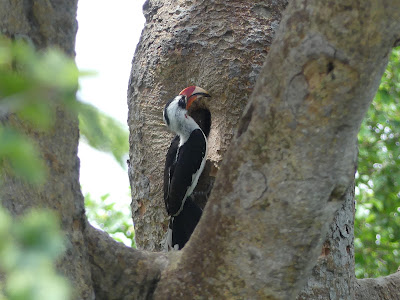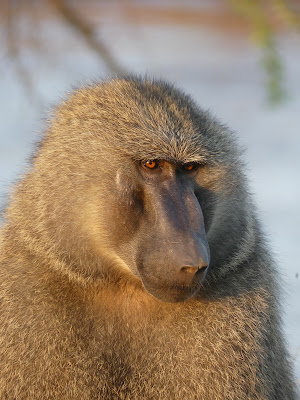Jambo! Here is our record of the birding trip in Kenya.
We flew to Kenya on November 1st and met Chege
the following morning for an early start at Nairobi National Park. We were also
joined by Edwin (someone hoping to do bird guiding in the near future as Chege
had agreed to show him some of the sites). We began seeing birds even before we reached the park, but here are some that were in Nairobi National Reserve.
Malachite Kingfisher
Dusky Turtle Dove
White-browed Sparrow-weaver
Grey Crowned Cranes
Three Banded Plover
Von Der Decken's Hornbill
Yellow-billed Stork and Sacred Ibis
During our first day (2nd), we found out that the
rains had started three weeks before and the amount of rainfall was equal if
not more than that usual for the summer months. This was unusual and may affect
the birds behaviour and therefore the species that we might see. We toured
Nairobi under blue skies punctuated with grey clouds. A complete list of
sightings will not be given each day, just a few photo highlights.
Masai Giraffes against the Nairobi skyline
Lionesses rest up
White Rhinos
Black Rhino with calf
Impala buck
After the park we drove on to Thika where we would spend the
night.
The transport for our safari
The next day (3rd) started with a problem. After
picking up a few new species in town, the road down to the sewage works had
been severely damaged by rainwater run-off. A substantial ditch had been dug
along the length closest to the access gate. It took some working around but we
eventually traversed the still flowing torrent, thanks to the land cruiser, and
got to within walking distance and checked out the settling beds.
A flooded roadway was only the start of problems at Thika sewage works.
The sewage works at Thika
Didric Cuckoo
Long-toed Plover
White-faced Whistling Ducks
Wood Sandpiper
Black-winged Stilt
As we left we found a White Stork carrying darvic T853 in a
waterlogged field.
White Stork with darvic T853.From enquiries we know this to be a bird ringed in Croatia, as a pullus in 2018. But we still await complete ringing details.
Blacksmith plover
It was a few hours to drive to Forest Lodge on the slopes of
Mount Kenya. We arrived during a downpour and although we started a walk when
it eased off, we were soon forced inside by the driving rain and lack of
visible birds.
At the foot of the road to Castle Lodge we got African Dusky
Flycatcher, before the weather closed in for the day.
Flycatcher, before the weather closed in for the day.
It had rained much of the night. The next day (4th)
dawned with a pall of cloud over the trees so raincoats were taken on the 5 hour
walk just in case they were needed. There seemed to be a lot of the expected
birds absent and this was put down to the weather. Even some of the species
that usually come to recorded calls failed to show. We thought some birds may
be breeding early due to the rains and no longer responsive to calls.
There was another walk in the afternoon – again birds were missed.
Northern Double-collared Sunbird
Hunter's Cisticola
White-eyed Slaty Flycatcher with young
A boiler to guarantee a hot shower
Threatening clouds blocked the view to Mount Kenya
There was another walk in the afternoon – again birds were missed.
We left Forest Lodge on the 5th and the guide decided to leave Kieni Forest
out of the planned itinerary, adding species along the way to Sirimon Gate,
Mount Kenya. We were not allowed entry as they couldn’t collect our payment due
to the system being down. This was a shame as the access road had been very
promising.
We were supposed to visit this on the way back, but it didn’t happen so guaranteed species on Mount Kenya went unseen. We continued on to Samburu National Reserve, entering through Buffalo Springs, one of three parks that combine to form the reserve.
Speckled Mousebird
African Stonechat (male)
Mountain Yellow Warbler
Common Zebra
We were supposed to visit this on the way back, but it didn’t happen so guaranteed species on Mount Kenya went unseen. We continued on to Samburu National Reserve, entering through Buffalo Springs, one of three parks that combine to form the reserve.
We had a very long lunch at Kentrout – the restaurant had no food and
sent out for supplies so a lot of time was spent with very little to show for it. Eventually we got on the move
towards Buffalo Springs, one of three reserves that form Samburu National Park.
We were pleased to be at Samburu (6th) as game drives produce animals as well as birds, even ‘though it meant not getting out of the vehicle, other than at designated areas. We spent some time searching for Leopard at a spot where Vervet Monkeys were intently watching a predator on the ground and issuing frequent, loud warning calls but the animal eluded us and remained unfound in its hiding spot.
We were pleased to be at Samburu (6th) as game drives produce animals as well as birds, even ‘though it meant not getting out of the vehicle, other than at designated areas. We spent some time searching for Leopard at a spot where Vervet Monkeys were intently watching a predator on the ground and issuing frequent, loud warning calls but the animal eluded us and remained unfound in its hiding spot.
Grevy's Zebra
Samburu is well known for the large herd of Elephants
Bull Elephant
Dwarf Mongoose
Reteculated Giraffe
Olive Baboon male
Vulturine Guineafowl
Black-faced Sandgrouse
The second day at Samburu (7th) was spent in Shaba where we trekked a long way to look for and eventually find William's Lark in the lava fields.
Adult Lion. Research has shown that manes tend to be
sparcer in individuals in hotter climates.
sparcer in individuals in hotter climates.
Violet Wood Hoopoe
Shaba had received much less rain than Samburu, a real contrast with dry shrivelled bushes rather than gushing streams and lush grass.
Shaba
Safari style birding
We had a picnic lunch at a place known as 'Joy's Camp'. This is where Joy Adamson based operations for her work in conserving African big cats, and where she was murdered in Jan 1980.
The watch tower was easily recognisable, a familiar scene from the 1960s film
'Born Free' about the work and life of Joy Adamson.
'Born Free' about the work and life of Joy Adamson.
Pygmy Falcon
On the morning of the 8th we spent our last morning in the park.
Grey- headed Kingfisher
Kori's Bustard
Temminck's Courser
Black-backed Jackel




















































